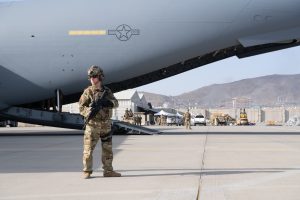On August 26, at least two explosions outside Hamid Karzai International Airport in Kabul reminded the world that the war in Afghanistan did not end with the Taliban’s entrance into the capital. A day earlier and overnight, the United States, United Kingdom, and Australia had issued warnings to their citizens to stay away from the airport, citing unspecified threats.
The latest information suggests a pair of suicide bombings, one at the airport’s Abbey Gate and another near the Baron Hotel, which is near the same gate. On Twitter, Pentagon spokesperson John Kirby called the blast “the result of a complex attack” and said that there were a number of U.S. and civilian casualties. Others have reported at least three U.S. servicemembers as wounded in the blast. Russian officials, per the Associated Press, said the pair of suicide bombings had resulted in at least 13 deaths and 15 wounded.
The Emergency Hospital in Kabul, as reported by the Wall Street Journal’s Ehsanullah Amiri, has taken in about 60 wounded people.
Given the densely packed crowds outside the airport, mostly Afghans struggling to get through ahead of the recently confirmed U.S. departure by August 31, the number of wounded and killed is likely to rise.
Kabul’s international airport has been the frantic center of evacuation efforts since the U.S.-backed Afghan government collapsed on August 15 and the Taliban entered the Afghan capital. It is the scene of a bizarre truce of sorts, as Taliban forces policed the approaches the airport and U.S. and international forces controlled the airport itself — sometimes within arms reach of each other.
As of Wednesday, per U.S. government statements, at least 88,000 people, including more than 4,400 U.S. citizens, had been evaluated from Kabul.
In recent days, the Taliban position shifted from allowing Afghans to flee to a Taliban spokesman saying earlier this week that “We are not in favor of allowing Afghans to leave.”
Although the attack has not been claimed, senior U.S. officials told the Associated Press that the August 25 warnings related to specific threats involving the Islamic State’s Afghanistan affiliate, known as Islamic State Khorasan (ISK, or ISIS-K). That said, there is no shortage of possible groups and individuals behind the blasts. The Taliban released thousands of prisoners from Pul-e-Charkhi, Afghanistan’s largest prison, in its approach to Kabul earlier this month, among them not just Taliban but al-Qaida and ISK members.
It’s not yet clear how the blasts will affect the ongoing evacuation efforts, although when confirming the U.S. would stick to the August 31 deadline earlier this week U.S. President Joe Biden suggested that overstaying that date raised the risk of attack at the airport.
“Every day we’re on the ground is another day we know that ISIS-K is seeking to target the airport and attack both U.S. and allied forces and innocent civilians,” Biden said in an August 24 speech.

































